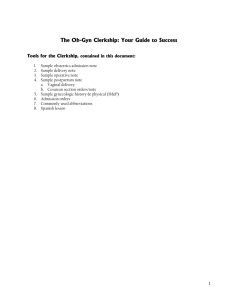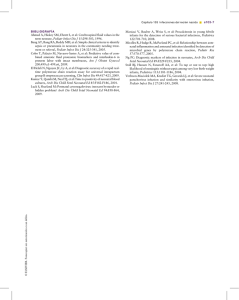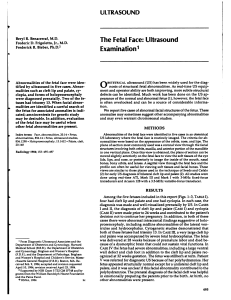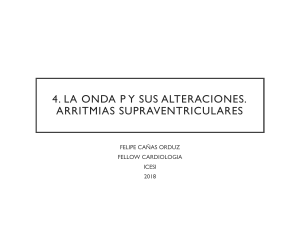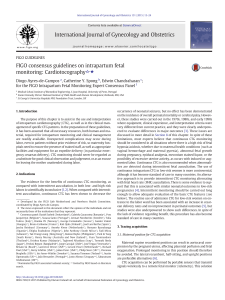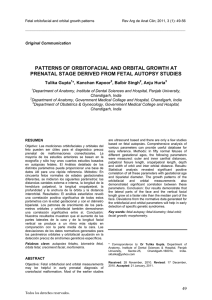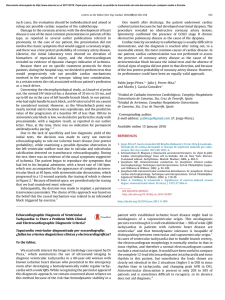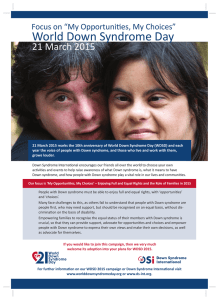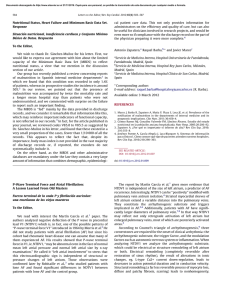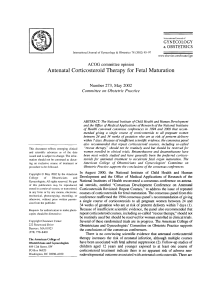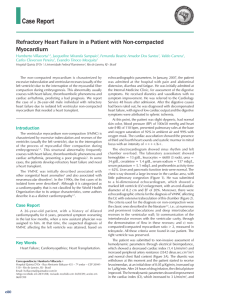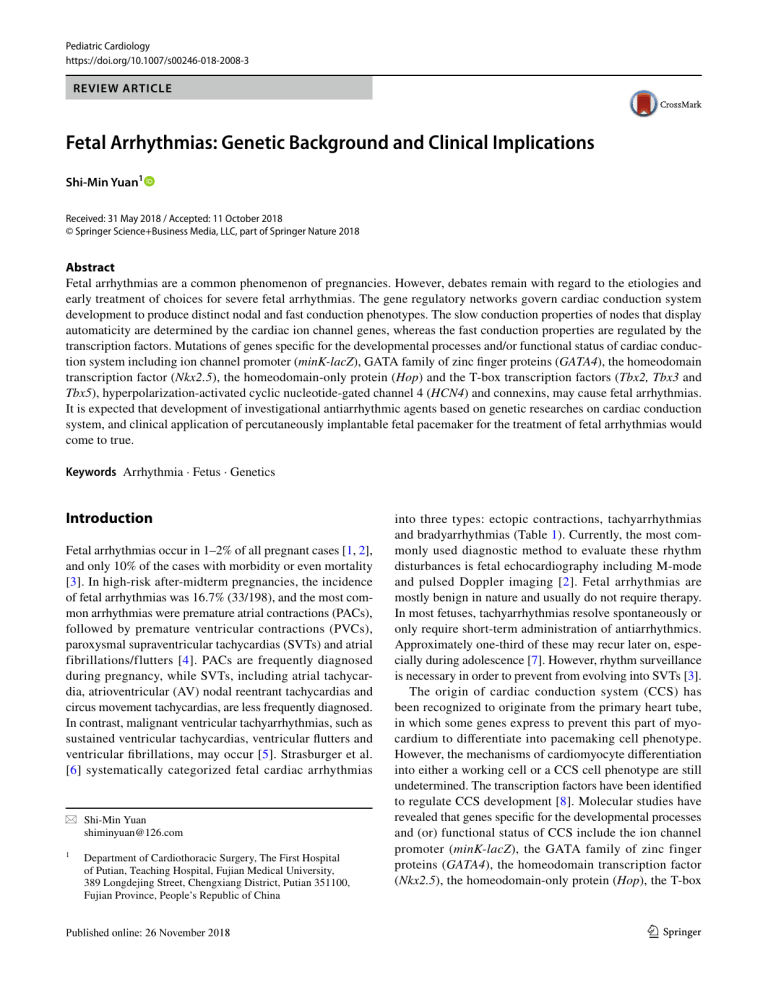
Pediatric Cardiology https://doi.org/10.1007/s00246-018-2008-3 REVIEW ARTICLE Fetal Arrhythmias: Genetic Background and Clinical Implications Shi‑Min Yuan1 Received: 31 May 2018 / Accepted: 11 October 2018 © Springer Science+Business Media, LLC, part of Springer Nature 2018 Abstract Fetal arrhythmias are a common phenomenon of pregnancies. However, debates remain with regard to the etiologies and early treatment of choices for severe fetal arrhythmias. The gene regulatory networks govern cardiac conduction system development to produce distinct nodal and fast conduction phenotypes. The slow conduction properties of nodes that display automaticity are determined by the cardiac ion channel genes, whereas the fast conduction properties are regulated by the transcription factors. Mutations of genes specific for the developmental processes and/or functional status of cardiac conduction system including ion channel promoter (minK-lacZ), GATA family of zinc finger proteins (GATA4), the homeodomain transcription factor (Nkx2.5), the homeodomain-only protein (Hop) and the T-box transcription factors (Tbx2, Tbx3 and Tbx5), hyperpolarization-activated cyclic nucleotide-gated channel 4 (HCN4) and connexins, may cause fetal arrhythmias. It is expected that development of investigational antiarrhythmic agents based on genetic researches on cardiac conduction system, and clinical application of percutaneously implantable fetal pacemaker for the treatment of fetal arrhythmias would come to true. Keywords Arrhythmia · Fetus · Genetics Introduction Fetal arrhythmias occur in 1–2% of all pregnant cases [1, 2], and only 10% of the cases with morbidity or even mortality [3]. In high-risk after-midterm pregnancies, the incidence of fetal arrhythmias was 16.7% (33/198), and the most common arrhythmias were premature atrial contractions (PACs), followed by premature ventricular contractions (PVCs), paroxysmal supraventricular tachycardias (SVTs) and atrial fibrillations/flutters [4]. PACs are frequently diagnosed during pregnancy, while SVTs, including atrial tachycardia, atrioventricular (AV) nodal reentrant tachycardias and circus movement tachycardias, are less frequently diagnosed. In contrast, malignant ventricular tachyarrhythmias, such as sustained ventricular tachycardias, ventricular flutters and ventricular fibrillations, may occur [5]. Strasburger et al. [6] systematically categorized fetal cardiac arrhythmias * Shi‑Min Yuan [email protected] 1 Department of Cardiothoracic Surgery, The First Hospital of Putian, Teaching Hospital, Fujian Medical University, 389 Longdejing Street, Chengxiang District, Putian 351100, Fujian Province, People’s Republic of China into three types: ectopic contractions, tachyarrhythmias and bradyarrhythmias (Table 1). Currently, the most commonly used diagnostic method to evaluate these rhythm disturbances is fetal echocardiography including M-mode and pulsed Doppler imaging [2]. Fetal arrhythmias are mostly benign in nature and usually do not require therapy. In most fetuses, tachyarrhythmias resolve spontaneously or only require short-term administration of antiarrhythmics. Approximately one-third of these may recur later on, especially during adolescence [7]. However, rhythm surveillance is necessary in order to prevent from evolving into SVTs [3]. The origin of cardiac conduction system (CCS) has been recognized to originate from the primary heart tube, in which some genes express to prevent this part of myocardium to differentiate into pacemaking cell phenotype. However, the mechanisms of cardiomyocyte differentiation into either a working cell or a CCS cell phenotype are still undetermined. The transcription factors have been identified to regulate CCS development [8]. Molecular studies have revealed that genes specific for the developmental processes and (or) functional status of CCS include the ion channel promoter (minK-lacZ), the GATA family of zinc finger proteins (GATA4), the homeodomain transcription factor (Nkx2.5), the homeodomain-only protein (Hop), the T-box 13 Vol.:(0123456789) Pediatric Cardiology Table 1 Classification of fetal arrhythmias Classification Perinatal arrhythmia Genetic or chromosomal abnormalities Premature contraction Premature atrial contraction; Premature ventricular contraction Sinus tachycardia; Supraventricular tachycardia; Atrial flutter; Junctional tachycardia; Ventricular tachycardia Blocked atrial ectopy; Sinus bradycardia; Second-degree and complete atrioventricular block; Low atrial or junctional bradycardia – – – – – – LQT1 form of long QT syndrome – LQT1 form of long QT syndrome Morgagni–Adams–Stokes syndrome Holt–Oram syndrome Tachyarrhythmia Bradyarrhythmia transcription factors (Tbx2, Tbx3 and Tbx5), the hyperpolarization-activated cyclic nucleotide-gated channel 4 (HCN4) and connexins [9]. Moreover, the growth and differentiation factor neuregulin induces cardiomyocytes to a CCS phenotype by induction of ectopic CCS-lacZ expression [10]. Endothelin-1 other than neuregulin also shows differentiation of atrial derived cardiomyocytes into a pacemaking phenotype in murine embryonic stem cells [11]. Adenosine monophosphate (AMP)-activated protein kinase (AMPK) mutation modifies AV septation during cardiogenesis, leading to ventricular preexcitation as a result of presence of accessory pathways [12]. A novel mutation of PRKAG2 gene in the γ2 regulatory subunit of AMPK is responsible for some CCS disorders. In brief, the exact mechanisms of the cardiac structure and CCS to arrhythmogenicity have not been fully elucidated. The purpose of this article is to given an overview of the genetic and clinical aspects of fetal arrhythmias. Genetic Backgrounds Research works focusing on arrhythmogenicity of cardiac structures have helped the understanding of the mechanisms of cardiac arrhythmias. The pathway theories proposed by James representing a posterior pathway (along the crista terminalis), an anterior pathway (to the left atrium via Bachmann’s bundle) and a medial pathway (in the interatrial septum) disclosed the specialized Purkinje-like and transitional cells based on histological studies primarily explained this phenomenon. Various cytokines found in different foci of the CCS inside the heart might be responsible for the conduction functions, for instance, the internodal tracts distinguished from the atrial myocardium in terms of expressions of the marker HNK1 may explain the underlying genetic backgrounds. The origin of the CCS cells has become an issue of interest. In the past, cardiomyocytes were thought to originate from the cardiac neural crest cells. Nowadays, the 13 cardiomyocytes are considered derived from a common myogenic precursor in the embryonic tubular heart. It has been found that, in the process of cardiomyocyte differentiation into a working myocardial cell or into a CCS cell, multifactorial inheritance other than a single gene is involved, and the growth and differentiation factor neuregulin plays a pivotal role in inducing them into a CCS phenotype, indicated by ectopic CCS-lacZ expression [10]. Specific transcription factors with members of zinc finger transcription factor family (GATA4, GATA6 and HF-1b), bHLH (MyoD), T-box (Tbx5) and homeodomain (Msx2 and Nkx2.5) typically expressed in the cardiac conduction cells, such as the AV node, the Purkinje fibers and the His bundle [13]. Mutations of these genes link to the abnormalities of the CCS (Table 2). In experimental animals, the lethality was proved to be caused by genetic interactions of GATA4 and GATA6 with Tbx5 in the CCS or due to abnormal contractile properties of the myocardium [14]. Tbx5 is a T-box containing transcription factor that is critical for proper limb and heart development. Tbx5 mutations that result in haploinsufficiency cause Holt–Oram syndrome, which is characterized by congenital heart defects, CCS abnormalities and upperlimb deformities [15]. The maturation of recently developed next-generation sequencing (NGS) technologies provides unprecedented sequencing capacity at dramatically lower cost, faster and more upgradable than other sequencing techniques. The NGS panels of fetal arrhythmias and their sensitivities are shown in Table 3. The price for an individual gene was $690 and for a full panel was $1670.00 [17]. Clinical Aspects Premature Contractions The majority of fetal arrhythmias are premature contractions. PVCs increased the risk to ventricular tachycardia and multiple PVCs usually increased the risk to PVTs. Cardiac inflow tract, atrioventricular canal, outflow tract and inner curvatures of the heart (putative slow conducting areas, His bundle and proximal part of the bundle branches) AV conduction system T-box family of transcription factors (Tbx2 and Tbx3) To drive the initial depolarization phase of the cardiac action potential and determine conduction of excitation [16] Regulate sodium current and repolarization Developing conduction system of the heart Correlation with electrical activation Fast conducting cardiac tissues and in the atria Electrical and metabolic coupling between cells (Cx40); slower conducting working myocardium of the atria and ventricles, and in the distal part of the conduction system (Cx43); slow conducting pathways and in the myocardium of the primary heart tube (Cx45) Regulation of cardiac ion channels [12] AV conduction AV atrioventricular, CCS cardiac conduction system Cardiac voltage-gated sodium channel α-subunit gene (SCN5A) PRKAG2 gene Cardiac conduction system (CCS)-lacZ gene Connexins Ventricular preexcitation Heart block Wolff–Parkinson–White syndrome Congenital long QT and Brugada syndromes Sinoatrial conduction defects (Cx40); sudden cardiac death from spontaneous ventricular arrhythmias (Cx43) Jervell-and Lange-Nielsen syndrome cardiac delayed rectifier currents Ikr and Iks (congenital long QT syndrome) Cardiac dysmorphogenesis with early embryonic mortality Conduction defects below the AV node Heart block, ion channel disorders, impaired depolarization in slow conduction tissue (hypoplasia of the AV node and His bundle, significantly reduced number of peripheral Purkinje fibers) Holt–Oram syndrome Repress Nppa (ANF) and Cx40 genes Suppress ANF promoter activity in the AV canal Typical cardiac phenotype Function Central CCS (but not the peripheral Purkinje A downstream target of Pax-3/splotch fibers) Homeobox gene Hop AV node, His bundle and bundle branches of the adult CCS The GATA family of transcription factors/zinc Adult and embryonic heart; Purkinje fibers finger subfamilies (GATA4); atrioventricular CCS and AV node (cGATA6) Mink gene (also known as IsK and KCNE1) Electrical currents in the heart Encoding protein modifying HERG and KvLQT1 Homeodomain transcription factor (Msx2) Homeodomain transcription factors (Nkx2.5) Site of expression Gene Table 2 Genetic backgrounds of cardiac arrhythmias Pediatric Cardiology 13 Pediatric Cardiology Table 3 NGS technologies for fetal arrhythmias [17–19] Clinical indication Genes Sensitivity (%) Arrhythmogenic right ventricular dysplasia CTNNA3, DES, DSG2, DSC2, DSP, JUP, LDB3, LMNA, PKP2, PLN, RYR2, TGFB3, TMEM43, TTN Short QT syndrome KCNH2, KCNQ1, KCNJ2 Long QT syndrome AKAP9, ANK2, CACNA1C, CALM1, CAV3, KCNE1, KCNE2, KCNH2, KCNJ2, KCNJ5, KCNQ1, NOS1AP, SCN4B, SCN5A, SNTA1 Brugada syndrome CACNA1C, CACNA2D1, CACNB2, GPD1L, HCN4, KCND3, KCNE1L, KCNE3, KCNH2, KCNJ8, RANGRF, SCN1B, SCN2B, SCN3B, SCN5A, SSCN5A, TRPM4 Sick-sinus syndrome HCN4, MYH6, SCN5A Catecholaminergic polymorphic ventricu- RYR2, CASQ2, CALM1 lar tachycardia (CPVT) Wloch et al. [20] reported 128 fetuses with PACs, 34% of which were benign. Most PAC cases have no genetic cause. However, some authors reported that PACs represented 22.2% (2/9) of a small fetal arrhythmia cohort next to SVT (66.7% (6/9)). They noted that PACs could also be a manifestation of Costello syndrome due to HRAS mutations [21]. In a clinical study involving 702 arrhythmic fetuses, 306 had an irregular rhythm, 298 (97.4%) of which had isolated premature contractions. PACs with first- or second-degree heart block or long PR duration were found in 3 (1.0%) cases at 23-, 28- and 32-week gestations, respectively. Many have aneurysmal septum primum with septum bowing and mechanical initiation of the PACs, and 1–2% of fetal cases of premature contractions were associated with other conditions, such as long QT syndrome or first- or second-degree heart block, or positivity of maternal SSA antibodies [22]. Respondek et al. [23] reported that 96% of the fetal arrhythmic cases had PACs as evidenced by fetal echocardiography at a mean of 34-week gestation. The fetal heart was structurally normal in most cases, and tricuspid valve regurgitation and atrial septal aneurysm were present in 14% cases each. Sole regular echocardiographic monitoring was applied in 86% of the cases and pharmacotherapy with digoxin, verapamil, or both was required in 14%. Fetal PVCs were less common than PACs. Fetal echocardiogram is recommended to assess cardiac structure and function and to determine the mechanism of the arrhythmia in fetuses with isolated PACs and multiple ectopic beats (bigeminy, trigeminy, or more than every 3–5 beats on average) [24]. PACs may be associated with congenital heart defects. They are usually benign and often resolve spontaneously, but follow-up is warranted for monitoring the development of ventricular tachycardia [3]. Fetal PVCs can be associated with cardiomyopathy, cardiac tumors, long QT syndrome, electrolyte imbalances and complete heart block with slow ventricular escape rhythm. Most fetal isolated PVCs usually disappear spontaneously before birth. Fetuses with sustained PVCs may usually 13 ~ 73 15–20 ~ 80 20–35 ~ 52–60 resolve within 6 weeks. They usually do not cause more complicated arrhythmias [25]. Tachyarrhythmias Fetal tachyarrhythmias typically include SVT, atrial flutter and ventricular tachycardia. Krapp et al. [26] reported that SVT accounted for 73.2% and atrial flutter accounted for 26.2% of fetal tachyarrhythmias. Hydrops fetalis was present in 38.6% and 40.5% of fetuses with atrial flutter and SVT, respectively. Fetal atrial flutter can be serious and fatal, especially in those with hydrops fetalis [27]. SVTs are frequently complicated by fetal congestive heart failure or even fetal death [3]. Idiopathic monomorphic ventricular tachycardia is probably caused by stationary vortex-like reentrant activity, while non-stationary reentry may be responsible for polymorphic ventricular tachycardia and ventricular fibrillation [28]. Timely prenatal pharmacotherapeutic intervention is generally advised to return it to sinus rhythm with an adequate heart rate [3]. The exact mechanism of fetal SVT was difficult to determine with Doppler magnetocardiogram, but currently Doppler myocardial deformation analysis is available for the diagnosis [29]. Mechanisms of SVT can be classified as AV reentrant, intraatrial reentrant and AV nodal reentrant [30, 31]. These three types of SVTs accounted for 73%, 14% and 13% of the cases, respectively, as reported by Ko et al. [30]. Kannankeril et al. [32] obtained similar results in their study of fetal tachycardias. Spontaneous resolution of SVT may occur in utero, during delivery, or after birth. There have been no definite regimens, and the treatment of choice is controversial. Digoxin is the first-line drug of choice in treating fetal SVTs in many centers; and in other centers, flecainide or procainamide has been used as a first-line agent, but its use is limited due to its higher pro-arrhythmic activity and its fetal-negative inotropic actions, which may exacerbate hydrops fetalis [33–35]. Sotalol, a β-adrenergic antagonist, is effective for the treatment of SVT in fetuses with or without hydrops Pediatric Cardiology fetalis [29, 36]. Digoxin and combined digoxin and sotalol or flecainide were very successful for the treatment of fetal SVTs [37–39]. Parilla et al. [40] employed, in eight hydropic fetuses, maternal intravenous administration (MIV) of digoxin or a combination of fetal intramuscular (FIM) digoxin and MIV with a mean duration of antiarrhythmic therapy of 9.6 ± 5.9 weeks, and achieved a shorter conversion time and a better conversion effect into sinus rhythm. Most recently, Wacker-Gussmann et al. [41] emphasized the importance of continuous monitoring of fetal tachyarrhythmias by fetal magnetocardiography. They recommended that sotalol was better than digoxin for fetal atrial flutter in conjunction with SVT, and that digoxin and (or) amiodarone were effective in restoring into sinus rhythm or decreasing the heart rate, but for the latter, the conversion rate was low. Fetal antiarrhythmic therapy can be associated with a much better survival in comparison to those without treatment (5–10% vs. 27–50%) [29]. Bradyarrhythmias Heart Block with Maternal Autoantibodies or Fetal Cardiac Structure Anomaly Fetal bradycardias may develop in the condition of fetal hypoxia [1], congenital heart defects [42], maternal systemic lupus erythematosus or Sjögren syndrome [43], maternal autoantibodies to SSA/Ro and (or) SSB/La ribonucleoproteins [43], or with an unknown etiology [44]. Fetal complete heart block in a structurally normal heart is frequently associated with maternal anti-Ro/SSA and anti-La/SSB autoantibodies with an incidence of 2% [45]. Lee et al. [46] recommended a close echocardiographic monitoring of fetal heart block to prevent from progression into complete heart block, and they also shared their successful experiences of treating fetal first-degree heart block by dexamethasone. Perín et al. [47] reported a fetus whose mother was with positive anti-Ro and anti-La antibodies presented with alternative tachy- and bradycardias. The baby required postnatal pacemaker implant. Jaeggi et al. [48] described 59 cases of fetal heart block with 24 (41%) having major congenital heart defects, 18 of which were left isomerism and 3 were transposition of the great arteries. Lopes et al. [49] reported a similar finding, showing that 59 of 116 (50.9%) cases of fetal heart block were associated with major structural heart disease, mainly left atrial isomerism. Miyoshi et al. [50] described 29 cases of fetal bradyarrhythmia associated with congenital heart defects and noted that the fetuses had a higher mortality rate, particularly in the context of fetal myocardial dysfunction and hydrops fetalis, irrespective of in utero treatment with ritodrine hydrochloride. Vesel et al. [51] reported a continuous infusion of isoprenaline failed to raise the very low ventricular rate of a fetus with complete heart block; thus, a permanent ventricular rate modulated pacing endocardial pacemaker was implanted a few hours after birth. Donofrio et al. [24] reported two cases of fetal complete heart block. An early delivery was suggested for worsening cardiovascular conditions, and an epicardial pacemaker was implanted early after birth in both cases. Fetal heart block in relation to cardiac structural defects denotes poor prognosis and left atrial isomerism displays the highest mortality. Dismal effects were seen even with pacing or supportive treatments [44]. Sinus Bradycardia, Sinus Node Dysfunction (Ion Channelopathies and Long QT Syndrome) and Low Atrial and Junctional Rhythm (NKX2.5, HCN4, SCN5A and Left Atrial Isomerism, etc.) The most common early manifestation of fetal long QT syndrome was sinus bradycardia, seen in fetuses of < 25-week gestation, while other fetal arrhythmias associated with fetal long QT syndrome, between 28- and 40-week gestations [52]. The cardiotocogram study revealed persistent fetal sinus bradycardia was associated with long QT syndrome in 71% of the cases [53]. The diagnosis of fetal sinus bradycardia is feasible by revealing a prolonged QT interval by magnetocardiography [53]. It has been recognized that long QT syndrome is caused by delayed repolarization of the ventricular cells due to a decreased repolarizing current and (or) an increased depolarizing current [54]. Cuneo et al. [55] found, in fetal long QT syndrome, 18% polymorphic ventricular tachycardia resembling Torsades de Pointes. They proposed that early afterdepolarizations was the cause of Torsades de Pointes in such cases. Mutations of genes encoding potassium channels (KCNQ1, KCNH2, KCNE1 and KCNJ2, etc), encoding sodium channels (SCN5A and SCN4B) and encoding calcium channels (CACN1C, CACN2B and CACN2D1) might be responsible for the development of long QT syndrome [54]. Long QT syndrome or other cardiac channelopathy warrants an electrocardiogram and genetic screening [56]. Change et al. [57] reported a case of fetal long QT syndrome underwent successful postnatal administration with the potassium channel opener nicorandil, by shortening the QT interval and improving the outcome. In addition, transplacental lidocaine could effectively treat fetal heart block and terminate ventricular tachycardia [55]. Sinus node dysfunction is most frequently caused by the presence of congenital defect and sinoatrial node deficiency. Patients with sinus node dysfunction may be asymptomatic or with tachy- or bradycardia. Bravo-valenzuela [58] reported a case of fetal bradycardia with sinus node dysfunction, in whom severe bradycardia developed after birth and surgical pacemaker implant was required. 13 Pediatric Cardiology Left atrial isomerism is characterized by “a large azygos continuation of an interrupted inferior vena cava, heart block and viscerocardiac heterotaxy on echocardiography” [59]. In some fetuses, persistent sinus or low atrial bradycardia may be present. A short PR interval bradycardia usually denotes a low atrial rhythm, as seen in left atrial isomerism due to the absence of the sinus node. Fetal sinus bradycardia and low atrial bradycardia usually demonstrate heart rate reactivity. However, either sinus or low atrial bradycardia does not need any specific treatment and is usually with no hemodynamic compromise after birth [44]. The prognosis of fetal junctional rhythm is also good. Wakai et al. [60] reported a case of fetal junctional rhythm associated with respiratory arrhythmia disclosed by fetal magnetocardiography, and the baby recovered to normal sinus rhythm at 10 days of life. Blocked Atrial Bigeminy Differential diagnostic criteria between blocked atrial bigeminy and heart block have drawn much attention regarding the distinct management policies. Blocked atrial bigeminy may persist for hours but is clinically benign with no need of treatment, while fetal complete heart block without structural heart disease has a better prognosis, which is mainly related to the transplacental passage of maternal autoantibodies directed to fetal Ro/SSA ribonucleoproteins [1]. Blocked atrial bigeminy can be a marker of a reentry pathway, which might cause tachycardia in 6–12% of cases [61]. A heart rate of < 60 beats/min suggests the probable diagnosis is third-degree heart block [61]. Eliasson et al. [61] proposed the concept of “interval between two conducted atrial beats (acb/acc)”, which clearly differentiated fetal blocked atrial bigeminy from second-degree heart block: intermittent blocked atrial bigeminy was diagnosed at 21–40-week gestation and the acb/acc ratio was < 0.35, whereas in cases with second-degree heart block, the ratio was 0.50. Wiggins et al. [62] proposed to distinguish blocked atrial bigeminy from 2:1 heart block by ectopic P wave on fetal magnetocardiography. Blocked atrial bigeminy usually resolves spontaneously in most fetal cases without the need of treatment; however, close rhythm monitoring is necessary to prevent it from developing into severe dysrhythmias [62]. In a fetus reported by Martucci et al. [47], blocked atrial bigeminy was evolving into SVT in utero. After birth, the baby required lanoxin syrup and subsequently sotalol, and the baby’s condition was then improved. Fetal echocardiography may disclose the mechanism of fetal arrhythmias and help in decision-making of antiarrhythmic therapy [63]. The maternal steroid therapy for fetal heart block is controversial. Breur et al. [64] summarized the steroid treatment (with prednisone or prednisolone, and with additional dexamethasone in two cases) of fetal heart block in 43 fetuses, the effective rate was 80%, while in 13 18% cases, complete heart block persisted in spite of steroid treatment, and in 2%, second-degree heart block during fetal life became first-degree at birth. Jaeggi et al. [65] reported that 22 fetuses with fetal complete heart block were treated with dexamethasone in 21 cases and with β-stimulation in 9 cases for an average of 7.5 weeks. The patients treated with dexamethasone had a much higher 1-year survival rate than those without (90% vs. 46%, p < 0.02). Ion Channelopathies A genetic linkage has been found between ion channel gene mutations and long QT syndrome, and the major genes that have been found are KCNQ1, KCNH2 and SCN5A [66]. Inherited arrhythmogenic syndromes caused by ion channel dysfunctions at membrane level (mutations in protein-encoding genes with gain or loss of function) may lead to lifethreatening arrhythmias, syncope and sudden death [67]. Research showed that the 470+ allelic mutations induce loss of function in the passage of mainly potassium ions, and gain-of-function in the passage of sodium ions through their respective ion channels. The resultant early afterdepolarizations could lead to a polymorphic form of cardiac bradycardia [68]. Addison et al. [69] examined the postmortem muscle or heart tissue samples from 46 unexplained stillbirths. In total 11 variants, three in LQT genes (AKAP9, KCNJ2 and KCNE2) and four in GWAS genes (BAZ2B, RYR2, TRPM7 and CAV2) were predicted to be functionally damaging. Dysfunction of the cardiac L-type calcium channel ­CaV1.2 and de novo ­CaV1.2 missense mutation G406R cause prolonged calcium ion current, delayed cardiomyocyte repolarization and an increased risk of arrhythmia [70]. CPU 86017, a new derivative of berberine, exerts its blockade directly on the ion channel itself [71]. Familial Bradyarrhythmia Family bradycardia is associated with mutations of the pacemaker channel gene hHCN4, which contributes to negative f-channel in the sinoatrial node [72]. S672R mutation in the cAMP-binding domain of HCN4 is a direct cause of familial bradycardia or arrhythmia [73]. Familial bradycardia is rarely reported in fetal cases. In a case of postnatal bradycardia with syncope due to severe bradyarrhythmia, implantation of a permanent ventricular demand pacemaker was indicated. His family history was positive in five persons of four generations for bradyarrhythmias. A high-grade heart block and ST–T changes in precordial leads recorded in all affected family members suggested familial conduction abnormality [74]. A case of fetal bradycardia at a heart rate of 50 beats/min noted at 28-week gestation persisted until 42-week gestation when an asymptomatic male baby was delivered. Electrocardiography at 3 weeks of age revealed an incessant Pediatric Cardiology atrial fibrillation with slow ventricular response. He continued to be asymptomatic; however, at 16 year of age, a heart rate of 23 beats/min and pauses of up to 6 s warranted an endocardial pacing system of a ventricular rate modulated pacing program. He seemed to have a good prognosis [75]. Familial forms of primary sinus bradycardia have sometimes been attributed to mutations of HCN4, SCN5A and ANK2, but mutations of HCN4 ion channel gene may be associated with cardiac structural anomalies [76]. A basic study in mouse revealed that HCN4 was a novel target for posttranscriptional repression by miR-423-5p and the training-induced downregulation of HCN4, and the bradycardia was a result of upregulated Nkx2.5 and consequently miR-423-5p in the sinus node [77]. Tbx5 mutations can be a mechanism of Holt–Oram syndrome and responsible for the associated long QT syndrome, while SCN5A mutations cause Brugada syndrome [78]. Bradyarrhythmias can be benign and requires no treatment; however, acute unstable bradycardia can lead to cardiac arrest. Management of bradycardia is based on the severity of symptoms, the underlying causes, the presence of adverse signs, and the risk of progression to asystole. Pharmacologic therapy and (or) pacing is used to manage unstable or symptomatic bradyarrhythmias [79]. Basic Science The T-type calcium channels are normally expressed in fetal ventricular myocytes. Basic research revealed that the T-type calcium channel currents were enhanced in hypoxic conditions, thereby disturbing the cardiac contraction pattern and leading to occurrence of arrhythmias [80]. When the dominant-negative form of neuron-restrictive silencer factor transgenic mice (dnNRSF-Tg) was treated with efonidipine or mibefradil, the selective T-type calcium channel antagonists, by reversing depolarization of the resting membrane potential, the incidence of sudden death and arrhythmogenicity in mice was significantly reduced [81]. Animal experiments in a passive antibody transfer model by using several different rat strains and major histocompatibility complex (MHC)/non-MHC congenics revealed that intraperitoneal injection of the Ro52 monoclonal antibody (7.8C7) was associated with significant PR prolongation and that both fetal MHC and non-MHC genes regulated susceptibility to complete heart block, determining the fetal outcomes in the presence of maternal anti-Ro52 positivity [82]. Hoxha et al. [83] investigated the reactivity of a monoclonal anti-Ro52 antibody in inducing heart block in rats (7.8C7) and of sera from anti-Ro52p200 antibody-positive mothers of complete heart block offsprings. Their results supported the hypothesis that maternal anti-Ro/SSA positivity might predispose to fetal heart block. Breast cancer resistance protein (BCRP) is known for its protective function against the toxic effects of the exogenous compounds. A pharmacokinetic model of the placental perfusion study using rat placental HRP-1 cell line and dually perfused rat placenta revealed that the transporter had a two-level defensive role in placenta: to reduce passage of its substrates from mother to fetus, and to remove the drug in the fetal circulation [84]. Drugs for transplacental treatment of fetal tachyarrhythmias include digoxin, sotalol, flecainide, amiodarone, propranolol, verapamil, procapone and procaine, etc. However, in the transplacental approach, the drug from mother to fetus passes through the placental trophoblast cells, which may be affected by the efflux of BCRP, affecting the amount of the trophoblast into the fetus, and leading to treatment failure. It has been reported that digoxin and verapamil are not the substrates of BCRP [85, 86]. Wang et al. [87] carried out an experiment by using MDCKII-BCRP and MDCKII cell monolayer models to investigate the candidatures of antiarrhythmic drugs as BCRP substrates. They found that flecainide, instead of sotalol, propranolol, propafenone and procainamide, can be a substrate of BCRP. Thus, the effect of flecainide may be affected by the BCRP in the maternal placental trophoblast membrane layer when treating fetal tachyarrhythmias. The Medical Device Development Facility in Los Angeles, CA, USA has invented a percutaneously implantable fetal pacemaker. Preclinical testing of the pacemaker in fetal sheep models has preliminarily proved the advantages of the device, including minimally invasive implantation, successful ventricular capture, effective myocardial contraction, and device reliability and durability. The newly developed fetal pacemaker could be a feasible treatment of choice for fetal bradyarrhythmias, especially in those fetuses with hydrops fetalis [88, 89]. Conclusions Genes like minK-lacZ, GATA4, the homeodomain transcription factor Nkx2.5, Hop and the T-box transcription factors Tbx2, Tbx3 and Tbx5, HCN4 and connexins, etc., might be involved in the developmental processes and (or) functional status of CCS. For most fetal cases with benign arrhythmias, maternal autoantibody screening and close follow-up are necessary in order to define the possible etiology and to prevent from progression into malignant arrhythmias, while for severe cases even those with heart dysfunction or hydrops fetalis, maternal or fetal antiarrhythmic medications are necessary. The selective T-type calcium channel antagonists can be a treatment of choice of fetal arrhythmias. Precaution with substrates of BCRP is recommended when using antiarrhythmic agents by transplacental approach. Immediate postnatal pacemaker implantation may be warranted in 13 Pediatric Cardiology the refractory cases. It is anticipated that the investigational agents in virtue of the genetic background of the CCS and early clinical use of the percutaneously implantable fetal pacemaker for the treatment of fetal arrhythmias could come to true in the near future to facilitate the management of fetal arrhythmias. Compliance with Ethical Standards Conflict of interest Author declares that he has no conflict of interest. Research Involving Human and Animal Participants This article does not contain any studies with human participants or animals performed by the author. Informed Consent Informed consent is not applicable for this study. References 1. Weber R, Stambach D, Jaeggi E (2011) Diagnosis and management of common fetal arrhythmias. J Saudi Heart Assoc 23(2):61–66 2. Cotton JL (2001) Identification of fetal atrial flutter by Doppler tissue imaging. Circulation 104(10):1206–1207 3. Alvarez A, Vial Y, Mivelaz Y, Di Bernardo S, Sekarski N, Meijboom EJ (2008) Fetal arrhythmias: premature atrial contractions and supraventricular tachycardia. Rev Med Suisse 4(166):1724– 1728 (Article in French) 4. Silverman NH, Enderlein MA, Stanger P, Teitel DF, Heymann MA, Golbus MS (1985) Recognition of fetal arrhythmias by echocardiography. J Clin Ultrasound 13(4):255–263 5. Trappe H-J (2010) Emergency therapy of maternal and fetal arrhythmias during pregnancy. J Emerg Trauma Shock 3(2):153–159 6. Strasburger JF, Cheulkar B, Wichman HJ (2007) Perinatal arrhythmias: diagnosis and management. Clin Perinatol 34(4):627–652, vii–viii 7. Sekarski N, Meijboom EJ, Di Bernardo S, Ksontini TB, Mivelaz Y (2014) Perinatal arrhythmias. Eur J Pediatr 173(8):983–996 8. Bakker ML, Christoffels VM, Moorman AFM (2011) Molecular basis and genetic aspects of the development of the cardiac chambers and conduction system: relevance to heart rhythm. In: Tripathi O, Ravens U, Sanguinetti M (eds) Heart rate and rhythm. Springer, Berlin, pp 231–253 9. Jongbloed MR, Mahtab EA, Blom NA, Schalij MJ, Gittenbergerde Groot AC (2008) Development of the cardiac conduction system and the possible relation to predilection sites of arrhythmogenesis. Sci World J 8:239–269 10. Rentschler S, Zander J, Meyers K, France D, Levine R, Porter G, Rivkees SA, Morley GE, Fishman GI (2002) Neuregulin-1 promotes formation of the murine cardiac conduction system. Proc Natl Acad Sci USA 99(16):10464–10469 11. Mahtab EAF, Jongbloed MRM, Blom NA, Schalij MJ, Gittenberger-de Groot AC (2008) Development of the cardiac conduction system and the possible relation to predilection sites of arrhythmogenesis, with special emphasis on the role of the posterior heart field. https: //openac cess. leiden univ. nl/bitstr eam/handl e/1887/13214/06.pdf?sequence=10. Accessed 29 Sept 2018 12. Gollob MH, Seger JJ, Gollob TN, Tapscott T, Gonzales O, Bachinski L, Roberts R (2001) Novel PRKAG2 mutation responsible for the genetic syndrome of ventricular preexcitation 13 13. 14. 15. 16. 17. 18. 19. 20. 21. 22. 23. 24. 25. 26. 27. 28. 29. and conduction system disease with childhood onset and absence of cardiac hypertrophy. Circulation 104(25):3030–3033 Harris BS, Jay PY, Rackley MS, Izumo S, O’Brien TX, Gourdie RG (2004) Transcriptional regulation of cardiac conduction system development: 2004 FASEB cardiac conduction system minimeeting, Washington, DC. Anat Record A 280A(2):1036–1045 Maitra M, Schluterman MK, Nichols HA, Richardson JA, Lo CW, Srivastava D, Garg V (2009) Interaction of Gata4 and Gata6 with Tbx5 is critical for normal cardiac development. Dev Biol 326(2):368–377 Basson CT, Bachinsky DR, Lin RC, Levi T, Elkins JA, Soults J et al (1997) Mutations in human TBX5 [corrected] cause limb and cardiac malformation in Holt-Oram syndrome. Nat Genet 15(1):30–35 Papadatos GA, Wallerstein PM, Head CE, Ratcliff R, Brady PA, Benndorf K et al (2002) Slowed conduction and ventricular tachycardia after targeted disruption of the cardiac sodium channel gene Scn5a. Proc Natl Acad Sci USA 99(9):6210–6215 Comprehensive cardiac ar rhythmia sequencing panel. https : //www.preve n tion g enet i cs.com/testI n fo. php?sel=test&val=Compr e hens i ve+Cardi a c+Arrhy t hmia +Sequencing+Panel. Accessed 29 Sept 2018 NGS fetale herzrythmusstörungen (kardiale arrhythmien). http://de.praenatal-medizin.de/glossary/ngs-fetale-herzrythmu sstoer ungen-kardiale-arrhythmien/. Accessed 29 Sept 2018 Arrhythmogenic right ventricular dysplasia/cardiomyopathy NGS panel. https: //www.asperb io.com/asper- cardio genet ics/ arrhyt hmoge nic-right- ventr i cular-dyspla siaca rdiomyopat hyngs-panel/. Accessed 29 Sept 2018 Wloch S, Wloch A, Respondek-Liberska M, Sikora J, Wilk K, Szydlowski L (2003) P306: Analysis of the mode of delivery in cases of fetal premature atrial contractions. Ultrasound Obstet Gynecol 22(Suppl 1):153 Lin AE, O’Brien B, Demmer LA, Almeda KK, Blanco CL, Glasow PF et al (2009) Prenatal features of Costello syndrome: ultrasonographic findings and atrial tachycardia. Prenat Diagn 29(7):682–690 Cuneo BF, Strasburger JF, Wakai RT, Ovadia M (2006) Conduction system disease in fetuses evaluated for irregular cardiac rhythm. Fetal Diagn Ther 21(3):307–313 Respondek M, Wloch A, Kaczmarek P, Borowski D, Wilczynski J, Helwich E (1997) Diagnostic and perinatal management of fetal extrasystole. Pediatr Cardiol 18(5):361–366 Donofrio MT, Gullquist SD, Mehta ID, Moskowitz WB (2004) Congenital complete heart block: fetal management protocol, review of the literature, and report of the smallest successful pacemaker implantation. J Perinatol 24(2):112–117 Radswiki SA Fetal premature ventricular contractions. https:// radiopaedia.org/articles/fetal-premature-ventricular-contractio ns. Accessed 29 Sept 2018 Krapp M, Kohl T, Simpson JM, Sharland GK, Katalinic A, Gembruch U (2003) Review of diagnosis, treatment, and outcome of fetal atrial flutter compared with supraventricular tachycardia. Heart 89(8):913–917 Lisowski LA, Verheijen PM, Benatar AA, Soyeur DJ, Stoutenbeek P, Brenner JI et al (2000) Atrial flutter in the perinatal age group: diagnosis, management and outcome. J Am Coll Cardiol 35(3):771–777 Samie FH, Jalife J (2001) Mechanisms underlying ventricular tachycardia and its transition to ventricular fibrillation in the structurally normal heart. Cardiovasc Res 50(2):242–250 Suri V, Keepanaseril A, Aggarwal N, Vijayvergiya R (2009) Prenatal management with digoxin and sotalol combination for fetal supraventricular tachycardia: case report and review of literature. Indian J Med Sci 63(9):411–414 Pediatric Cardiology 30. Ko JK, Deal BJ, Strasburger JF, Benson DW Jr (1992) Supraventricular tachycardia mechanisms and their age distribution in pediatric patients. Am J Cardiol 69(12):1028–1032 31. Naheed ZJ, Strasburger JF, Deal BJ, Benson DW Jr, Gidding SS (1996) Fetal tachycardia: mechanisms and predictors of hydrops fetalis. J Am Coll Cardiol 27(7):1736–1740 32. Kannankeril PJ, Gotteiner NL, Deal BJ, Johnsrude CL, Strasburger JF (2003) Location of accessory connection in infants presenting with supraventricular tachycardia in utero: clinical correlations. Am J Perinatol 20(3):115–119 33. Strasburger JF, Wakai RT (2010) Fetal cardiac arrhythmia detection and in utero therapy. Nat Rev Cardiol 7(5):277–290 34. Jaeggi EE, Fouron JC, Drblik SP (1998) Fetal atrial flutter: Diagnosis, clinical features, treatment, and outcome. J Pediatr 132(2):335–339 35. Donofrio MT, Moon-Grady AJ, Hornberger LK, Copel JA, Sklansky MS, Abuhamad A, American Heart Association Adults With Congenital Heart Disease Joint Committee of the Council on Cardiovascular Disease in the Young and Council on Clinical Cardiology, Council on Cardiovascular Surgery and Anesthesia, and Council on Cardiovascular and Stroke Nursing, et al (2014) Diagnosis and treatment of fetal cardiac disease: a scientific statement from the American Heart Association. Circulation 129(21):2183–2242 36. Oudijk MA, Michon MM, Kleinman CS, Kapusta L, Stoutenbeek P, Visser GH et al (2000) Sotalol in the treatment of fetal dysrhythmias. Circulation 101(23):2721–2726 37. D’Alto M, Russo MG, Paladini D, Di Salvo G, Romeo E, Ricci C et al (2008) The challenge of fetal dysrhythmias: echocardiographic diagnosis and clinical management. J Cardiovasc Med (Hagerstown) 9(2):153–160 38. Shah A, Moon-Grady A, Bhogal N, Collins KK, Tacy T, Brook M et al (2012) Effectiveness of sotalol as first-line therapy for fetal supraventricular tachyarrhythmias. Am J Cardiol 109(11):1614–1618 39. Porat S, Anteby EY, Hamani Y, Yagel S (2003) Fetal supraventricular tachycardia diagnosed and treated at 13 weeks of gestation: a case report. Ultrasound Obstet Gynecol 21(3):302–305 40. Parilla BV, Strasburger JF, Socol ML (1996) Fetal supraventricular tachycardia complicated by hydrops fetalis: a role for direct fetal intramuscular therapy. Am J Perinatol 13(8):483–486 41. Wacker-Gussmann A, Strasburger JF, Srinivasan S, Cuneo BF, Lutter W, Wakai RT (2016) Fetal atrial flutter: electrophysiology and associations with rhythms involving an accessory pathway. J Am Heart Assoc 5(6):e003673 42. Machado MV, Tynan MJ, Curry PV, Allan LD (1988) Fetal complete heart block. Br Heart J 60(6):512–515 43. Ayed K, Gorgi Y, Sfar I, Khrouf M (2004) Congenital heart block associated with maternal anti SSA/SSB antibodies: a report of four cases. Pathol Biol (Paris) 52(3):138–147 (Article in French) 44. Beaves M The fetal bradyarrhythmias. https://www.ogmagazine .org.au/19/2-19/the-fetal-bradycardia/. Accessed 29 Sept 2018 45. Dey M, Jose T, Shrivastava A, Wadhwa RD, Agarwal R, Nair V (2014) Complete congenital foetal heart block: a case report. Facts Views Vis Obgyn 6(1):39–42 46. Lee JY, Hur SE, Lee SK (2012) Prevention of anti-SSA/RO and anti-SSB/LA antibodies-mediated congenital heart block in pregnant woman with systemic lupus erythematosus: a case report. Korean J Obstet Gynecol 55(7):502–506 47. Perín F, del Rey MRV, Bronte LD, Menduina QF, Nuñez FR, Arguelles JZ, de la Calzada DG, Marin ST, Malfaz FC, Izquierdo AG (2014) Fetal bradycardia: a retrospective study in 9 Spanish centers. An Pediatr (Barc) 81(5):275–282 48. Jaeggi ET, Hornberger LK, Smallhorn JF, Fouron JC (2005) Prenatal diagnosis of complete atrioventricular block associated with structural heart disease: combined experience of two 49. 50. 51. 52. 53. 54. 55. 56. 57. 58. 59. 60. 61. 62. 63. 64. tertiary care centers and review of the literature. Ultrasound Obstet Gynecol 26(1):16–21 Lopes LM, Tavares GM, Damiano AP, Lopes MA, Aiello VD, Schultz R et al (2008) Perinatal outcome of fetal atrioventricular block: one-hundred-sixteen cases from a single institution. Circulation 118(12):1268–1275 Miyoshi T, Maeno Y, Sago H, Inamura N, Yasukouchi S, Kawataki M, Horigome H, Yoda H, Taketazu M, Shozu M, Nii M, Kato H, Hagiwara A, Omoto A, Shimizu W, Shiraishi I, Sakaguchi H, Nishimura K, Nakai M, Ueda K, Katsuragi S, Ikeda T (2015) Fetal bradyarrhythmia associated with congenital heart defects—nationwide survey in Japan. Circ J 79(4):854–861 Vesel S, Zavrsnik T, Podnar T (2003) Successful outcome in a fetus with an extremely low heart rate due to isolated complete congenital heart block. Ultrasound Obstet Gynecol 21(2):189–191 Murphy LL, Moon-Grady AJ, Cuneo BF, Wakai RT, Yu S, Kunic JD et al (2012) Developmentally regulated SCN5A splice variant potentiates dysfunction of a novel mutation associated with severe fetal arrhythmia. Heart Rhythm 9(4):590–597 Beinder E, Grancay T, Menéndez T, Singer H, Hofbeck M (2001) Fetal sinus bradycardia and the long QT syndrome. Am J Obstet Gynecol 185(3):743–747 Abriel H, Zaklyazminskaya EV (2013) Cardiac channelopathies: genetic and molecular mechanisms. Gene 517(1):1–11 Cuneo BF, Ovadia M, Strasburger JF, Zhao H, Petropulos T, Schneider J, Wakai RT (2003) Prenatal diagnosis and in utero treatment of torsades de pointes associated with congenital long QT syndrome. Am J Cardiol Jun 1;91(11):1395–1398 Cuneo BF, Strasburger JF, Yu S, Horigome H, Hosono T, Kandori A, Wakai RT (2013) In utero diagnosis of long QT syndrome by magnetocardiography. Circulation 128(20):2183–2191 Chang IK, Shyu MK, Lee CN, Kau ML, Ko YH, Chow SN, Hsieh FJ (2002) Prenatal diagnosis and treatment of fetal long QT syndrome: a case report. Prenat Diagn 22(13):1209–1212 Bravo-Valenzuela NJ (2013) Fetal bradycardia and sinus node dysfunction. Pediatr Cardiol 34(5):1250–1253 Phoon CK, Kim MY, Buyon JP, Friedman DM (2012) Finding the “PR-fect” solution: what is the best tool to measure fetal cardiac PR intervals for the detection and possible treatment of early conduction disease? Congenit Heart Dis 7(4):349–360 Wakai RT, Leuthold AC, Wilson AD, Martin CB (1997) Association of fetal junctional rhythm and respiratory arrhythmia detected by magnetocardiography. Pediatr Cardiol 18(3):201–203 Eliasson H, Wahren-Herlenius M, Sonesson SE (2011) Mechanisms in fetal bradyarrhythmia: 65 cases in a single center analyzed by Doppler flow echocardiographic techniques. Ultrasound Obstet Gynecol 37(2):172–178 Wiggins DL, Strasburger JF, Gotteiner NL, Cuneo B, Wakai RT (2013) Magnetophysiologic and echocardiographic comparison of blocked atrial bigeminy and 2:1 atrioventricular block in the fetus. Heart Rhythm 10(8):1192–1198 Donofrio MT, Moon-Grady AJ, Hornberger LK, Copel JA, Sklansky MS, Abuhamad A, Cuneo BF, Huhta JC, Jonas RA, Krishnan A, Lacey S, Lee W, Michelfelder EC Sr, Rempel GR, Silverman NH, Spray TL, Strasburger JF, Tworetzky W, Rychik J, American Heart Association Adults With Congenital Heart Disease Joint Committee of the Council on Cardiovascular Disease in the Young and Council on Clinical Cardiology, Council on Cardiovascular Surgery and Anesthesia, and Council on Cardiovascular and Stroke Nursing (2014) Diagnosis and treatment of fetal cardiac disease: a scientific statement from the American Heart Association. Circulation 129(21):2183–2242 (Erratum in Circulation 2014;129(21):e512) Breur JM, Visser GH, Kruize AA, Stoutenbeek P, Meijboom EJ (2004) Treatment of fetal heart block with maternal steroid 13 Pediatric Cardiology 65. 66. 67. 68. 69. 70. 71. 72. 73. 74. 75. 76. 77. 78. 79. therapy: case report and review of the literature. Ultrasound Obstet Gynecol 24(4):467–472 Jaeggi ET, Fouron JC, Silverman ED, Ryan G, Smallhorn J, Hornberger LK (2004) Transplacental fetal treatment improves the outcome of prenatally diagnosed complete atrioventricular block without structural heart disease. Circulation 110(12):1542–1548 Tester DJ, Ackerman MJ (2014) Genetics of long QT syndrome. Methodist Debakey Cardiovasc J 10(1):29–33 Dr S (2012) Ion channelopathies: overview and current status. Rev Cubana Invest Biomed 31(1):1–15 Modell SM, Lehmann MH (2006) The long qt syndrome family of cardiac ion channelopathies: a huGE review. Genet Med 8(3):143–155 Addison S, Munroe PB, Mein C, Cohen M, Fowler D, Sebire NJ et al (2014) 8.2 Cardiac ion channelopathies in unexplained stillbirths. Arch Dis Child Fetal Neonatal Ed 99(Suppl 1):A11 Splawski I, Timothy KW, Sharpe LM, Decher N, Kumar P, Bloise R, Napolitano C, Schwartz PJ, Joseph RM, Condouris K, TagerFlusberg H, Priori SG, Sanguinetti MC, Keating MT (2004) Ca(V)1.2 calcium channel dysfunction causes a multisystem disorder including arrhythmia and autism. Cell 119(1):19–31 Dai DZ, Zhang GQ, Yang P, Ma YP (2010) Two patterns of ion channelopathies relating to arrhythmias and direct and indirect blockade of ion channels by antiarrhythmic agents. Drug Dev Res 58(1):42–50 Milanesi R, Baruscotti M, Gnecchi-Ruscone T, DiFrancesco D (2006) Familial sinus bradycardia associated with a mutation in the cardiac pacemaker channel. N Engl J Med 354(2):151–157 Tsai CJ, Nussinov R (2017) Allostery modulates the beat rate of a cardiac pacemaker. J Biol Chem 292(15):6429–6430 Bertram H, Paul T, Beyer F, Kallfelz HC (1996) Familial idiopathic atrial fibrillation with bradyarrhythmia. Eur J Pediatr 155(1):7–10 Aburawi E, Thomson J, Blackburn M (2006) Familial idiopathic atrial fibrillation with fetal bradyarrhythmia. Acta Paediatr 95(12):1700–1702 Milano A, Vermeer AMC, Lodder EM, Barc J, Verkerk AO, Postma AV et al (2014) Hcn4 mutations in multiple families with bradycardia and left ventricular noncompaction cardiomyopathy. J Am Coll Cardiol 64(8):745–756 D’Souza A, Pearman CM, Wang Y, Nakao S, Logantha SJRJ, Cox C, Bennett H, Zhang Y, Johnsen AB, Linscheid N, Poulsen PC, Elliott J, Coulson J, McPhee J, Robertson A, da Costa Martins PA, Kitmitto A, Wisløff U, Cartwright EJ, Monfredi O, Lundby A, Dobrzynski H, Oceandy D, Morris GM, Boyett MR (2017) Targeting miR-423-5p reverses exercise training-induced hcn4 channel remodeling and sinus bradycardia. Circ Res 121(9):1058–1068 Fan C, Duhagon M, Oberti C, Chen S, Hiroi Y, Komuro I et al (2003) Novel TBX5 mutations and molecular mechanism for Holt-Oram syndrome. J Med Genet 40(3):e29 Wung SF (2016) Bradyarrhythmias: clinical presentation, diagnosis, and management. Crit Care Nurs Clin North Am 28(3):297–308 13 80. González-Rodríguez P, Falcón D, Castro MJ, Ureña J, LópezBarneo J, Castellano A (2015) Hypoxic induction of T-type ­Ca2+ channels in rat cardiac myocytes: role of HIF-1α and RhoA/ ROCK signalling. J Physiol 593(21):4729–4745 81. Kinoshita H, Kuwahara K, Takano M, Arai Y, Kuwabara Y, Yasuno S, Nakagawa Y, Nakanishi M, Harada M, Fujiwara M, Murakami M, Ueshima K, Nakao K (2009) T-type ­Ca2+ channel blockade prevents sudden death in mice with heart failure. Circulation 120(9):743–752 82. Dzikaite V, Strandberg LS, Ambrosi A, Jagodic M, Janson P, Khademi M et al (2010) MHC genes determine fetal susceptibility in a rat model of congenital heart block. In: International Workshop on Clinical and Molecular Aspects of Congenital, p 269. https ://ard.bmj.com/content/annrheumdis/71/Suppl_1/A54.3.full.pdf. Accessed 29 Sept 2018 83. Hoxha A, Ruffatti A, Ambrosi A, Ottosson V, Hedlund M, Ottosson L, Anandapadamanaban M, Sunnerhagen M, Sonesson SE, Wahren-Herlenius M (2016) Identification of discrete epitopes of Ro52p200 and association with fetal cardiac conduction system manifestations in a rodent model. Clin Exp Immunol 186(3):284–291 84. Frantisek S, Zuzana V, Katerina P, Petr P, Martina C, Lenka C et al (2006) Expression and transport activity of breast cancer resistance protein (Bcrp/Abcg2) in dually perfused rat placenta and HRP-1 cell line. In: Proceedings of the fifteenth international pharmacology conference, vol 319, p 53 85. Taipalensuu J, Tavelin S, Lazorova L, Svensson AC, Artursson P (2004) Exploring the quantitative relationship between the level of MDR1 transcript, protein and function using digoxin as a marker of MDR1-dependent drug efflux activity. Eur J Pharm Sci 21(1):69–75 86. Römermann K, Wanek T, Bankstahl M, Bankstahl JP, Fedrowitz M, Müller M, Löscher W, Kuntner C, Langer O (2013) (R)-[11C] verapamil is selectively transported by murine and human P-glycoprotein at the blood-brain barrier, and not by MRP1 and BCRP. Nucl Med Biol 40(7):873–878 87. Wang W, Zhao JJ, Wang T, Wang L, Jiang XH (2015) Transplacental transport mechanisms of drugs for transplacental treatment of fetal tachyarrhythmia of MDCKII/MDCKII-BCRP cell line. Yao Xue Xue Bao 50(3):305–311 (Article in Chinese) 88. Loeb GE, Zhou L, Zheng K, Nicholson A, Peck RA, Krishnan A, Silka M, Pruetz J, Chmait R, Bar-Cohen Y (2013) Design and testing of a percutaneously implantable fetal pacemaker. Ann Biomed Eng 41(1):17–27 89. Zhou L, Vest AN, Chmait RH, Bar-Cohen Y, Pruetz J, Silka M, Zheng K, Peck R, Loeb GE (2014) A percutaneously implantable fetal pacemaker. Conf Proc IEEE Eng Med Biol Soc 2014:4459–4463
